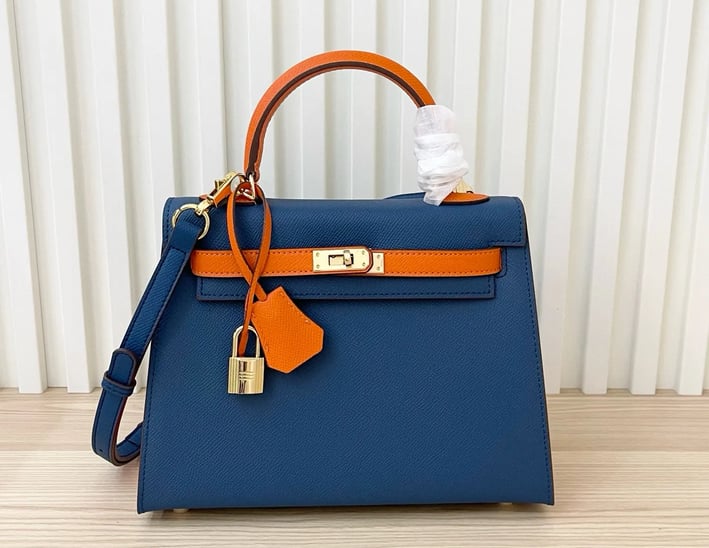Exploring Hand-Stitching Techniques in Authentic Moroccan Handbags
8 min read


Introduction to Authentic Moroccan Handbags
Authentic Moroccan handbags hold a significant place in the world of fashion, embodying both cultural heritage and artisanal craftsmanship. These handbags, often crafted by skilled artisans, reflect the rich history and traditions of Morocco, showcasing intricate designs, vibrant colors, and quality materials. The distinctiveness of these handbags not only lies in their aesthetic appeal but also in the stories they tell about the regions and communities from which they originate.
Among the noteworthy styles are the sac élégance and sculptura maxi tote, each offering unique design elements that elevate them beyond mere accessories. The sac élégance is characterized by its structured silhouette and elegant craftsmanship, making it a statement piece for various occasions. Its design often incorporates traditional Moroccan motifs and patterns, paying homage to the country's artistic legacy. On the other hand, the sculptura maxi tote stands out with its modern design while retaining traditional elements, providing functionality and style combined. The spacious interiors of these totes cater to the needs of contemporary women, emphasizing practicality without compromising aesthetics.
The importance of ethical fashion craftsmanship cannot be overstated in today’s market, as consumers become increasingly aware of the environmental and social impacts of their purchasing decisions. Authentic Moroccan handbags are often made with eco-friendly materials and sustainable practices, ensuring that each piece is not just a fashionable item but also a responsible choice. Supporting local artisans contributes to the preservation of traditional craftsmanship and empowers communities economically.
In essence, exploring authentic Moroccan handbags entails an appreciation of their unique attributes, cultural significance, and the ethical responsibilities associated with their creation. The sac élégance and sculptura maxi tote exemplify this convergence of artistry, functionality, and sustainability, representing a thoughtful choice in the realm of modern fashion.
The Art of Hand-Stitching: A Timeless Technique
Hand-stitching is an age-old craft that embodies not only skill but also cultural heritage, particularly in the realm of Moroccan handbag production. The sac élégance and sculptura maxi tote exemplify the dedication required to master this technique. Artisans utilize a variety of stitching styles which contribute to both the structure and visual appeal of these handbags. Among the most common techniques are the saddle stitch and whip stitch, each providing unique strengths and aesthetics. The saddle stitch, for instance, offers superior durability, allowing the handbags to withstand daily use over extended periods. The whip stitch, on the other hand, enhances the visual intricacy, creating patterns that delight the eyes and elevate the overall design of the bag.
To achieve precision in their craft, artisans carefully select their tools. A sharp needle and high-quality waxed thread are crucial for creating strong seams that will not easily fray. The choice of materials is equally important—not only for their aesthetic qualities but their functional attributes as well. High-grade leather, often sourced from local tanneries, ensures that the final product is both luxurious and rugged. Additionally, tools such as pricking irons and stitching awls help artisans maintain consistent spacing and alignment throughout the stitching process, a testament to their dedication to craftsmanship.
The intricacy involved in hand-stitching these bags allows for a level of customization that mass-produced items simply cannot offer. Each handbag becomes a unique piece of art that reflects the artisan's skill and the rich culture of Morocco. As the emphasis on handmade goods continues to grow, understanding the nuances of hand-stitching ensures greater appreciation for the beauty and durability embodied in each sac élégance and sculptura maxi tote.
Interview with Simulated Artisans: Voices Behind the Craft
In the heart of Morocco, a rich tapestry of tradition and craftsmanship flourishes, particularly evident in the creation of authentic Moroccan handbags. Throughout generations, artisans have honed their skills in hand-stitching techniques, passing down their knowledge and passion to younger craftsmen. In this section, we delve into the experiences of these artisans, shining a light on the challenges they encounter and the pride they derive from their work.
Each artisan has a unique story, often intertwined with family legacies that date back decades, if not centuries. For example, Fatima, a skilled artisan from Marrakech, recalls her grandmother teaching her the intricate techniques of hand-stitching. "It is not just a job for me; it is a way to honor my heritage," she states. Fatima's commitment to traditional methods is palpable, as she expresses a desire to maintain the authenticity of Moroccan handbags while adapting to modern designs. This balancing act is something many artisans face, as they strive to keep the essence of their craft alive amidst changing consumer preferences.
However, challenges abound in this niche industry. Amina, another artisan, discusses the pressures of competition and the struggle against mass-produced alternatives that flood the market. "It is difficult to convey the true value of hand-stitched pieces,” she explains. “While they may be higher priced, the quality and the story behind each bag make them irreplaceable." Despite these hurdles, the artisans remain steadfast, drawing strength from their community and the rich cultural heritage they represent.
The pride expressed by these artisans is palpable, with many emphasizing the joy of seeing their creations worn and appreciated by customers around the world. They emphasize that each handbag tells a story, reflecting not only their skill but also the cultural significance rooted in Moroccan tradition. As we explore the artistry of hand-stitched handbags, it becomes clear that behind every crafted piece lies a deep connection to history and the passion of those who create them.
Sourcing Materials: The Role of the Atlas Mountains
The Atlas Mountains, stretching across Morocco, serve as a vital source for materials used in creating the iconic sac élégance and sculptura maxi tote handbags. This region is renowned for its rich natural resources, particularly high-quality leather, textiles, and dyes that reflect the area's cultural heritage. By utilizing locally sourced materials, these handbags not only embody authenticity but also celebrate the artisanal craftsmanship that Moroccan artisans are known for.
One of the primary materials harvested from the Atlas Mountains is leather, derived from the hides of local livestock. This leather is favored for its durability and flexibility, enhancing the longevity of the handbags. The careful and traditional tanning methods passed down through generations impart a unique character to each piece, further elevating its appeal. The artisans’ commitment to ethical sourcing practices ensures that this leather is obtained responsibly, fostering local economies and supporting sustainable livelihoods.
In addition to leather, the use of natural dyes sourced from the Atlas Mountains significantly contributes to the richness of colors found in the sac élégance and sculptura maxi tote. These vegetable-based dyes are environmentally friendly and create vibrant, organic hues that resonate with the landscape's natural beauty. Utilizing these dyes not only enhances the visual allure of the bags but also aligns with eco-conscious consumer values, providing assurance that no harmful chemicals are involved in the dyeing process.
Overall, the importance of the materials sourced from the Atlas Mountains cannot be understated. Not only do they contribute to the unique craftsmanship of the sac élégance and sculptura maxi tote, but they also play a crucial role in promoting ethical and sustainable practices that benefit both the artisans and the environment. This commitment to quality and sustainability resonates with discerning consumers seeking luxury handbags with a story and purpose.
Time-Per-Piece Metrics: Understanding Craftsmanship in Fashion
The craftsmanship inherent in the creation of authentic Moroccan handbags, such as the sac élégance and sculptura maxi tote, is intricately measured by time-per-piece metrics. These metrics quantify the amount of time artisans dedicate to each handbag, reflecting a profound commitment to quality and detail. The meticulous hand-stitching techniques employed in these creations require significant time investment, often spanning several days to complete a single piece. This extended timeframe is a critical indicator of the level of craftsmanship involved in the production process.
When assessing the making of the sac élégance and sculptura maxi tote, it is essential to recognize that each handbag is not merely a fashion accessory; it represents a labor of love and expertise. Artisans spend hours selecting high-quality materials and carefully crafting each stitch to ensure durability and aesthetic appeal. This attention to detail not only elevates the handbag's visual appeal but also ensures that it meets the high standards expected in the luxury fashion market.
The time-per-piece metrics also play a crucial role in understanding the significance of handmade products within the context of ethical fashion. As consumers increasingly seek to support sustainable practices, it is vital to recognize the artisans' efforts behind each handbag. By valuing the time and skill invested in these pieces, consumers can make informed choices that support ethical labor and traditional craftsmanship. The distinction between mass-produced items and handcrafted bags is stark, with the latter offering a connection to cultural heritage and the artisan's skill.
Ultimately, the time investment in the sac élégance and sculptura maxi tote underlines the importance of valuing handmade products in contemporary fashion. As the demand for ethical choices grows, understanding these metrics becomes crucial for appreciating the artistry involved in creating unique, quality accessories.
The Intersection of Fashion and Ethics: A New Era of Consumer Awareness
In recent years, the fashion industry has witnessed a significant shift towards ethical practices and sustainable choices. As consumers become increasingly aware of the environmental and social implications of their purchases, the demand for ethical fashion continues to rise. This growing trend has led many individuals to reassess their consumer habits, seeking products that not only reflect their personal style but also align with their values. Authentic Moroccan handbags, such as the Sac Élégance and Sculptura Maxi Tote, serve as prime examples of this movement, showcasing artisanal craftsmanship while adhering to principles of sustainability.
Ethical fashion emphasizes transparency in production processes, ensuring that artisans are fairly compensated for their labor and that materials are sourced responsibly. By choosing such products, consumers have the opportunity to make a positive impact on both the environment and the communities involved in producing these goods. Authentic Moroccan handbags often use locally sourced materials and traditional, hand-stitching techniques, which not only contribute to the preservation of cultural heritage but also reduce the carbon footprint associated with mass production. The unique designs of these handbags further reflect the individuality of the artisans, creating a connection between the consumer and the craftsmanship.
Moreover, by supporting ethically made Moroccan handbags, consumers are participating in a broader movement that values quality over quantity. This shift towards conscious consumption encourages brands to adopt sustainable practices, thereby fostering a healthier fashion ecosystem. Consumers can support this initiative by researching brands, looking for certifications or labels that signify ethical practices, and engaging with stories of artisans behind the products. As awareness of ethical fashion grows, the intersection of style and ethics becomes increasingly relevant, guiding consumer choices in a more sustainable direction.
Conclusion: Celebrating Artisanship in Every Stitch
The exploration of hand-stitching techniques in authentic Moroccan handbags, particularly the Sac Élégance and Sculptura Maxi Tote, highlights the significant role that craftsmanship plays in the creation of these exquisite pieces. Each handbag is not merely an accessory; it is a representation of the rich cultural heritage and the skilled artisans behind its creation. The meticulous hand-stitching techniques employed are at the heart of these creations, ensuring both durability and aesthetic appeal. This dedication to craftsmanship reflects a deep-seated respect for traditional methods and a commitment to ethical production practices.
As we have discussed, the hand-stitching process enhances the uniqueness of each handbag, making them one-of-a-kind items that tell a story. When consumers choose to invest in authentic Moroccan handbags, they are not only acquiring a fashionable accessory but also supporting artisans and their communities. This conscious approach to fashion encourages a more sustainable and responsible consumption model, where the emphasis is on quality over quantity. Learning about the techniques and materials used in these bags fosters a deeper appreciation for the time and effort invested in their creation.
In conclusion, by celebrating the artisanship inherent in every stitch of the Sac Élégance and Sculptura Maxi Tote, we can foster a sense of connection to the products we choose to incorporate into our lives. Recognizing the stories behind these handbags allows us to make more informed purchasing decisions and promotes an ethical approach to fashion. Let us cherish not only the beauty of what we wear but also the craftsmanship and tradition that make each piece truly special.
Discover our luxurious bags and women's apparel
Contact us:
© 2025. All rights reserved
Partners




